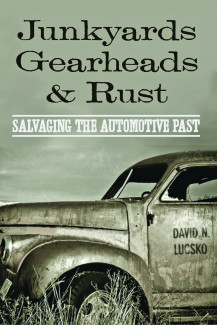
Johns Hopkins UniversityEst. 1876
America’s First Research University
Q&A with David Lucsko

David N. Lucsko is an associate professor of history at Auburn University. His latest book, Junkyards, Gearheads & Rust: Salvaging the Automotive Past is available now. He is also the author of The Business of Speed: The Hot Rod Industry in America, 1915–1990. We sat down with David to get a behind-the-scenes look at the making of his latest project.
Q: Why did you decide to write this book?
For as long as I can remember, I’ve been fascinated by salvage yards. The toy I wanted most the first Christmas I can remember was “Clyde’s Car Crusher,” a toy junkyard setup that let you form cars out of foil and then crush them in a miniature junkyard crusher. I didn’t get that toy – probably because I was way too little at the time for it! – but the following year I sort of got what I wanted: we moved to a new house, and out of my new bedroom window I could just make out over the horizon the cranes at a nearby car salvage yard. So I wasn’t able to “play junkyard” in my room, but I could watch the cranes from my window. For a little kid who was fascinated by salvage yards, it was heaven.
I’ve also been a car enthusiast for as long as I can remember, and as I grew up and started working on old cars, I started to visit salvage yards for odds and ends. I was also a voracious consumer of car magazines, in which rags-to-riches stories of “junkyard finds” abounded. So basically, I grew up working on cars, and reading about them, and trips to salvage yards were part and parcel of that experience. It was something that I took for granted; just part of the experience of being a gearhead.
Fast forward a bit, and I found myself in graduate school, working on a dissertation about hot rods. And while researching that project, and the subsequent JHUP book that derived from it (The Business of Speed, 2008), I began to amass quite a collection of references to salvage yards and the sorts of things car enthusiasts do with the parts and cars they find in them. I began collecting them simply because I thought they were interesting—they were reminders of the car culture of my youth. But by the time I finished the first book project, I had become convinced that there was a lot more going on in the realm of car enthusiasts and salvage yards than just a trip down memory lane. In light of what was then (and still is) a fast-growing area of research within the history of technology concerned with reuse and recycling, I was convinced that I could do a follow-up to The Business of Speed that would look at the relationship between car enthusiasts and salvage yards in the United States. Not a history of the scrap-metal business, nor a straightforward history of the auto salvage parts business, but a history of car enthusiasts and salvage yards. And I’m glad I chose to do so: researching and writing this book has been tremendously rewarding, and tremendously fun.
Q: What were some of the most surprising things you learned while writing/researching the book?
To me the most surprising was the extent to which the specialty salvage business is concentrated in the American Southwest. (Here I mean that part of the salvage industry that caters specifically to car enthusiasts.) I knew going in that parts from Arizona and California are coveted by enthusiasts, but the extent to which Arizona, California, and other arid states are statistically overrepresented in the business really surprised me. Again, I knew they would be important, but I didn’t know how important.
Q: What is new about your book/research that sets it apart from other books in the field?
Junkyards, Gearheads, and Rust is less concerned with the scrap-metal recycling business and more concerned with the direct re-use and repurposing of parts and cars from salvage yards. So unlike previous scholarship, this book emphasizes what happens to cars after they are no longer on the road, but before they head into the shredder and the scrap-metal furnace. It is a story of creative reuse and adaptation: of customizers using metal from wrecked cars in their endeavors, of hot rodders using engines pulled from wrecks in their projects, of restoration enthusiasts searching for elusive “holy grail” parts for their projects, and so forth. It is also a story about the regulation of junkyard businesses and cars deemed “junky” or “eyesores” by the authorities—as well as about the ways car enthusiasts have pushed back against the regulatory marginalization of their pastimes.
Q: Did you encounter any eye opening statistics while writing your book?
As I noted above, the extent to which the American southwest is statistically overrepresented in the specialty salvage business surprised me. Every gearhead knows that if you want the best, most rust-free used parts for your project, you’ll want to look to the southwest. Every gearhead knows that, and going in, I knew it too, at least in an informal, seat-of-the-pants sort of way. But I didn’t expect the statistics to confirm this impression so overwhelmingly.
Q: Does your book uncover and/or debunk any longstanding myths?
Several of the chapters in Junkyards, Gearheads, and Rust tackle the question of collectability: what makes certain old cars collectible, while others remain neglectable? Drawing on the work of the anthropologist Michael Thompson, I was able to explore the real-world ways in which value, age, scarcity, and desirability have interacted over the years within the old-car hobby. One of the main take-home lessons is that scarcity does not necessarily lead to collectability. Another lesson is that the unloved cars of “today” (whenever “today” is, whether the 1950s from the point of view of the 1950s, the 1970s from the point of view of the 1970s, or the 1990s from the point of view of the 1990s)—the unloved cars of “today” do tend in time to become collectible to someone, somewhere down the line. We might think of the cars of “today” as hopelessly boring and undesirable, that is, but time does tend to work some magic in this regard. In other words, it’s tempting to think that the notion that “the cars of today are bland and will never be collectible” is a new attitude, one that surely dates to the 1980s and 1990s, as enthusiasts looked back wistfully at the 1950s and 1960s. But it’s actually a trope you find across time: journalists were bemoaning the “boring cars of today” in the early 1950s, and they were doing the same thing in the 1970s, and the 1980s, and the 1990s, and so forth.
Q: What is the single most important fact revealed in your book and why is it significant?
From the final chapter, on old-car scrappage programs, it is important to stress that the overwhelming majority of old cars still on the road are not “gross polluters.” The idea that removing them from the streets and crushing them will somehow solve our problems with air pollution is naïve at best, and utterly destructive at worst.
Q: How do you envision the lasting impact of your book?
If it leads even a few people to think again when they see a car on the road with faded paint, or to think again when they pass a junkyard, or to think again when they see a nicely restored car in a parade – if it leads even a few to a deeper understanding of how these are interrelated, or to a deeper understanding of the longstanding culture of creative reuse, repurposing, and – dare I say it? – recycling that is involved, I will be happy.



